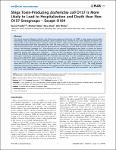Shiga Toxin-Producing Escherichia coli O157 Is More Likely to Lead to Hospitalization and Death than Non-O157 Serogroups – Except O104
Preußel, Karina
Höhle, Michael
Stark, Klaus
Werber, Dirk
The clinical spectrum following infection with Shiga toxin-producing Escherichia coli (STEC) is wide ranging and includes hemorrhagic colitis and life-threatening hemolytic uremic syndrome (HUS). Severity of STEC illness depends on patients' age and strongly on the infecting strains' virulence. Serogroup O157 is often assumed to be more virulent than others. Age-adjusted population-based data supporting this view are lacking thus far. We conducted a large retrospective cohort study among patients of community-acquired gastroenteritis or HUS diagnosed with STEC infection, reported in Germany January 2004 through December 2011. Age-adjusted risks for reported hospitalization and death, as proxies for disease severity, were estimated for STEC serogroups separately, and compared with STEC O157 (reference group) using Poisson regression models with robust error estimation. A total of 8,400 case-patients were included in the analysis; for 2,454 (29%) and 30 (0.4%) hospitalization and death was reported, respectively. Highest risks for hospitalization, adjusted for age and region of residence, were estimated for STEC O104 (68%; risk ratio [RR], 1.33; 95% confidence interval [CI], 1.19–1.45), followed by STEC O157 (46%). Hospitalization risks for the most prevalent non-O157 serogroups (O26, O103, O91, O145, O128, O111) were consistently and markedly lower than for O157, with the highest RR for O145 (0.54; 95% CI, 0.41–0.70) and the lowest for O103 (0.27; 95% CI, 0.20–0.35). Mortality risk of O104 was similar to O157 (1.2% each), but the group of all other non-O157 STEC had only 1/10 the risk (RR, 0.09; 95% CI, 0.02–0.32) compared to O157. The study provides population-based and age-adjusted evidence for the exceptional high virulence of STEC O157 in relation to non-O157 STEC other than O104. Timely diagnosis and surveillance of STEC infections should prioritize HUS-associated E. coli, of which STEC O157 is the most important serogroup.
No license information

